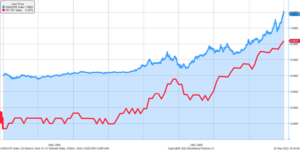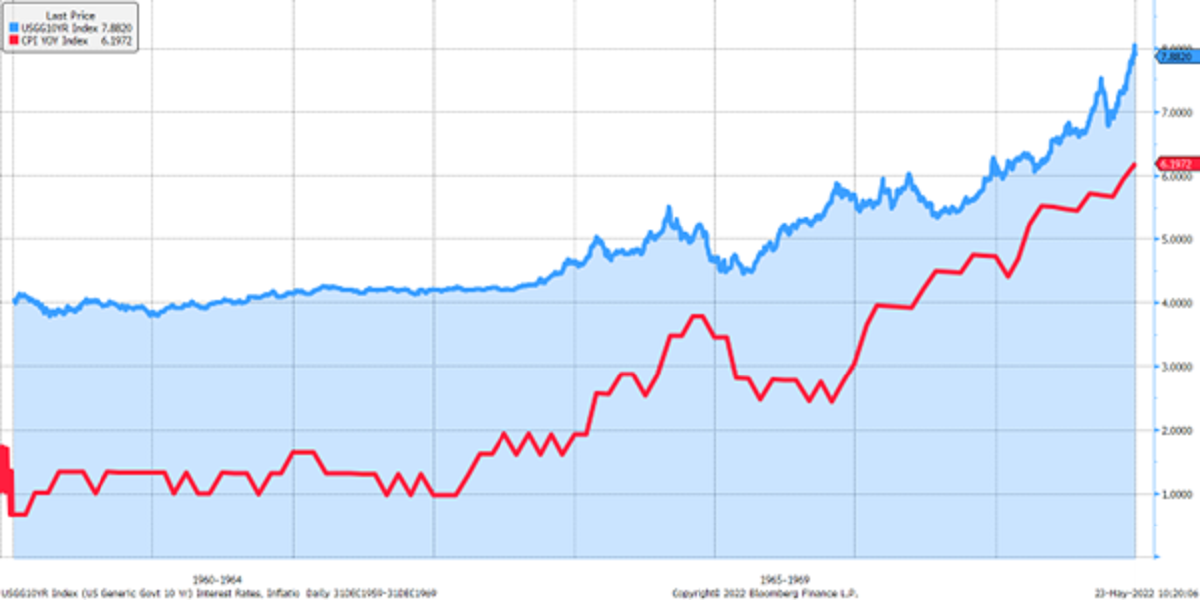By Smead Capital Management. Originally published at ValueWalk.

Dear fellow investors,
“The stock market is there to serve you and not to instruct you.” – Warren Buffett. May 5th, 1997 at the Berkshire Hathaway Annual Shareholder Meeting
What The Stock Or Bond Markets Are Telling Us
The future is always unknown. One of the most common fallacies that we’ve heard over the last two years is investors saying to us what the stock market or bond markets are telling us about the future. We find this interesting because it doesn’t tell you anything. As Buffett says, these market prices can serve you, but they can’t instruct you. We would like to share a couple of historical examples to settle this debate.
Q1 2022 hedge fund letters, conferences and more
Let’s begin with what the markets were teaching investors during the early 1960s. Below is a chart of the 10-year U.S. Treasury back to 1962 (as far back as Bloomberg goes) and inflation back to 1960. During the early 1960s, inflation was subdued at less than 2% and interest rates stay persistent at around 4%. To use the current illogical thinking of today, an investor at the beginning of 1965 could be asking what the markets were telling us about the future.
The answer was nothing. The 10-year Treasury went from 4.20% to 7.88% while inflation ended the 1960s at 6.20%. The person that bought the 10-year note at the beginning of 1965 nominally made less than 5% on a total return-basis and lost over 15% in real returns. If the stock market investor purchased the S&P 500 at that same time, they would have made roughly 27.50% cumulatively, including dividends reinvested. If you count the cumulative inflation of that period (that amounted to over 20% total), the S&P 500 investor made 1-2% compounded in real returns. The low inflation and steady Treasury rates of the early 1960s taught them nothing about the future.
Let’s look at the more recent past. In the depths of the lockdowns in the spring of 2020, investors feared the worst. Luckily, Wall Street had a framework for guiding them (shock). People peddled ideas that the markets were showing us a picture of the future in the ways that capital would be allocated in the post-pandemic world. Oil went negative in the futures (not at the pump). Work from home stocks soared, but all real economy stocks got crushed. Bond prices soared.
We cannot understate how dangerous the psychology is of thinking that the markets teach you anything. The 10-year yield hit 0.54% on March 9th of 2020. Inflation, which was slow to follow, would crater to a level of 0.12% over the prior year by the end of that May. Wall Street worked their magic pedaling the idea that a new paradigm was being shown to investors in securities markets pricing. People bought this belief hook, line and sinker. Wall Street sold it so well that by August 4th of 2020, though inflation had begun to pick up rapidly, bond investors took the 10-year Treasury note to a yield of 51 basis points! The likes of which we don’t expect to see again in our lifetime.
The Future Of The Economy
Investors believed that they were being shown the future of the economy, the price of money and what companies were going to win going forward. Using the stock investors’ return, the S&P 500 Index from the beginning of 2020 to today has made roughly 28%. Inflation in 2020 and 2021 has already eaten over 8% of that return. If we prayed to end up with inflation of 6% by the end of 2022, the real return for the S&P 500 would be only 12-14% for the three-year period. My guess is that we go to negative real returns for 2020-2022 on the S&P 500.
Investors have also taken this view of the future from markets into select industries. Many investors are currently talking about where the 30-year fixed mortgage rate has gone, at over 5%, and are predicting calamity in housing. Why? Because they think that interest rates tell you about the future of housing. They don’t. The lowest interest rates produced paltry home builds looking back 10 years. The supply issue of today isn’t changed by interest rates. At best, it affects near-term demand. In the long run, marriage and babies build houses.
Be very careful when taking macroeconomics into predicting the future, a colleague of mine was at a bar recently watching the Phoenix Suns fail to beat the Dallas Mavericks in the NBA playoffs. When a person there learned what my colleague did, he told him that based on what stocks and inflation are telling us that a recession is guaranteed at this point. In other words, the markets are telling us…
This is being pushed by not just Wall Street, but by many media outlets, as of late, with a bearish flair on the economic outlook. In a May 19th, 2022 The New York Times article titled Amateur Investor Rode the Bull Up. Now the Bear Looms, the author wrote, “Five months of bumpy declines have put the S&P 500 on the precipice of a bear market: A drop of 20 percent or more from its most recent high, which is considered a psychological marker of investors’ dimmed view of the economy.” Do you see what they are doing? They are saying that asset prices are telling us something about the economy.
One other note on this, Zoltan Pozsar of Credit Suisse has made a name for himself in talking about this subject. He deserves credit for his work. The one thing that we disagree with him on is his point that good is bad. He points out that the strong balance sheets of corporations and households are not good, but bad, because the Federal Reserve is going to be far more aggressive. We agree with Pozsar’s aggressiveness argument but disagree about who it is bad for. This is a nightmare for the S&P 500 and the bond market, like it was beginning in 1965. The Fed couldn’t change aggregate demand five years ago. Pozsar believes they can at least reduce it now. We think history has proven that they are ineffective at affecting demand. An act of God is the only thing that we’ve seen with effectiveness at aggregate demand.
As stock pickers, we have to be very humble about the fact that the future is unknown. The stock market and bond market teach us nothing about the future. Particularly in the stock market, many participants lose money. Stock market failure is always present.
The price declines of U.S. homebuilders and Canadian lumber stocks recently teach the investors of Smead Capital Management nothing while the investment business thinks they find empirical importance based on the changes of prices in those securities. Target’s (TGT) recent price decline off of their quarterly earnings doesn’t teach us anything about the long-term prospects of their business. It just teaches us that investors got way too excited about their near-term success. The markets are telling us…nothing. We seek to use today’s 10-year Treasury yields, inflation and securities pricing to serve the investors of Smead Capital Management while the investment community frets about the economy and stares at stock market failure in the S&P 500.
Fear stock market failure,
Cole Smead, CFA
The information contained in this missive represents Smead Capital Management’s opinions, and should not be construed as personalized or individualized investment advice and are subject to change. Past performance is no guarantee of future results. Cole Smead, CFA, President and Portfolio Manager, wrote this article. It should not be assumed that investing in any securities mentioned above will or will not be profitable. Portfolio composition is subject to change at any time and references to specific securities, industries and sectors in this letter are not recommendations to purchase or sell any particular security. Current and future portfolio holdings are subject to risk. In preparing this document, SCM has relied upon and assumed, without independent verification, the accuracy and completeness of all information available from public sources. A list of all recommendations made by Smead Capital Management within the past twelve-month period is available upon request.
©2022 Smead Capital Management, Inc. All rights reserved.
This Missive and others are available at www.smeadcap.com.
Updated on
Sign up for ValueWalk’s free newsletter here.




